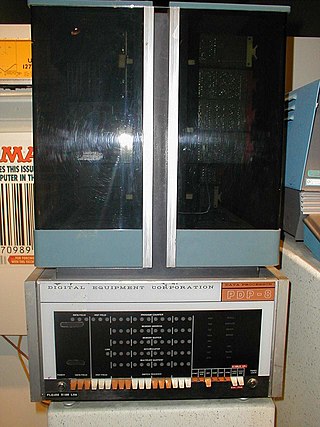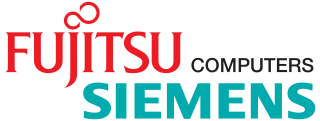Related Research Articles

Multiple Virtual Storage, more commonly called MVS, is the most commonly used operating system on the System/370, System/390 and IBM Z IBM mainframe computers. IBM developed MVS, along with OS/VS1 and SVS, as a successor to OS/360. It is unrelated to IBM's other mainframe operating system lines, e.g., VSE, VM, TPF.

A mainframe computer, informally called a mainframe or big iron, is a computer used primarily by large organizations for critical applications like bulk data processing for tasks such as censuses, industry and consumer statistics, enterprise resource planning, and large-scale transaction processing. A mainframe computer is large but not as large as a supercomputer and has more processing power than some other classes of computers, such as minicomputers, servers, workstations, and personal computers. Most large-scale computer-system architectures were established in the 1960s, but they continue to evolve. Mainframe computers are often used as servers.

A minicomputer, or colloquially mini, is a type of smaller general-purpose computer developed in the mid-1960s and sold at a much lower price than mainframe and mid-size computers from IBM and its direct competitors. In a 1970 survey, The New York Times suggested a consensus definition of a minicomputer as a machine costing less than US$25,000, with an input-output device such as a teleprinter and at least four thousand words of memory, that is capable of running programs in a higher level language, such as Fortran or BASIC.

The IBM System/360 (S/360) is a family of mainframe computer systems that was announced by IBM on April 7, 1964, and delivered between 1965 and 1978. It was the first family of computers designed to cover both commercial and scientific applications and a complete range of applications from small to large. The design distinguished between architecture and implementation, allowing IBM to release a suite of compatible designs at different prices. All but the only partially compatible Model 44 and the most expensive systems use microcode to implement the instruction set, featuring 8-bit byte addressing and binary, decimal and hexadecimal floating-point calculations.
Open systems are computer systems that provide some combination of interoperability, portability, and open software standards..

Hercules is a computer emulator allowing software written for IBM mainframe computers and for plug compatible mainframes to run on other types of computer hardware, notably on low-cost personal computers. Development started in 1999 by Roger Bowler, a mainframe systems programmer.

The IBM System/370 (S/370) is a model range of IBM mainframe computers announced on June 30, 1970, as the successors to the System/360 family. The series mostly maintains backward compatibility with the S/360, allowing an easy migration path for customers; this, plus improved performance, were the dominant themes of the product announcement. In September 1990, the System/370 line was replaced with the System/390.

Gene Myron Amdahl was an American computer architect and high-tech entrepreneur, chiefly known for his work on mainframe computers at IBM and later his own companies, especially Amdahl Corporation. He formulated Amdahl's law, which states a fundamental limitation of parallel computing.

Amdahl Corporation was an information technology company which specialized in IBM mainframe-compatible computer products, some of which were regarded as supercomputers competing with those from Cray Research. Founded in 1970 by Gene Amdahl, a former IBM computer engineer best known as chief architect of System/360, it has been a wholly owned subsidiary of Fujitsu since 1997. The company was located in Sunnyvale, California.
PL/S, short for Programming Language/Systems, is a "machine-oriented" programming language based on PL/I. It was developed by IBM in the late 1960s, under the name Basic Systems Language (BSL), as a replacement for assembly language on internal software projects; it included support for inline assembly and explicit control over register usage.

Fujitsu Siemens Computers GmbH was a Japanese and German vendor of information technology. The company was founded in 1999 as a 50/50 joint venture between Fujitsu Limited of Japan and Siemens of Germany. On April 1, 2009, the company became Fujitsu Technology Solutions as a result of Fujitsu buying out Siemens' share of the company.
The BUNCH was the nickname for the group of mainframe computer competitors of IBM in the 1970s. The name is derived from the names of the five companies: Burroughs, UNIVAC, NCR, Control Data Corporation (CDC), and Honeywell. These companies were grouped together because the market share of IBM was much higher than all of its competitors put together.
A logical partition (LPAR) is a subset of a computer's hardware resources, virtualized as a separate computer. In effect, a physical machine can be partitioned into multiple logical partitions, each hosting a separate instance of an operating system.
Since the rise of the personal computer in the 1980s, IBM and other vendors have created PC-based IBM-compatible mainframes which are compatible with the larger IBM mainframe computers. For a period of time PC-based mainframe-compatible systems had a lower price and did not require as much electricity or floor space. However, they sacrificed performance and were not as dependable as mainframe-class hardware. These products have been popular with mainframe developers, in education and training settings, for very small companies with non-critical processing, and in certain disaster relief roles.
Proprietary hardware is computer hardware whose interface is controlled by the proprietor, often under patent or trade-secret protection.
UTS is a discontinued implementation of the UNIX operating system for IBM mainframe computers. Amdahl created the first versions of UTS, and released it in May 1981, with UTS Global acquiring rights to the product in 2002. UTS Global has since gone out of business.
DOCS was a software package for IBM mainframes by CFS Inc., enabling access to the system console using 3270-compatible terminals.

Hitachi Data Systems (HDS) was a provider of modular mid-range and high-end computer data storage systems, software and services. Its operations are now a part of Hitachi Vantara.

The IBM System/360 Model 25 is a low-end member of the IBM System/360 family. It was announced on January 3, 1968, 3 years before the IBM System/360 Model 22, as a "bridge between its old and new computing systems".

The IBM 303X is a discontinued line of mainframe computers, the first model of which, the IBM 3033 Processor, nicknamed "The Big One", was introduced March 25, 1977.
References
- ↑ "plug-compatible". PC Magazine Encyclopedia. Ziff Davis.
- ↑ "Making the move into IBM-compatible peripheral products was a natural adjunct to products being developed for OEMs." "Moving into IBM-compatible peripheral products". Computerworld. August 18, 1980. p. 7.
- ↑ "plug-compatible mainframe (PCM)." "direct-mail company to replace IBM with PCM". Computerworld. March 8, 1982. p. 69.
- ↑ Herbert Hovenkamp (2017). Principles of Antitrust. ISBN 978-1640200821.
- ↑ Pugh; et al. (1991). IBM's 360 and Early 370 Systems . p. 233. ISBN 9780262161237.
- ↑ "Expected to produce $1 billion in revenues during fiscal 1980, CDC's peripherals business, advancing at 33% annually, is the fastest growing revenue producer within the company's diverse product line." "CDC PCM Peripherals - $1 Billion market". Computerworld. August 18, 1980. p. 7.
- ↑ "GSA has initiated a Government-wide program.to replace existing leased peripheral devices with lower cost plug-to-plug compatible equipment offered by independent suppliers. This program was aimed at permitting competitive offers of peripherals by independent suppliers." The Creative Partnership: Government and the Professional Services. 1973.
- ↑ "... to allow the use of IBM plug-compatible peripherals on the CDC 6400, 6600 and 7600 systems installed at the LBL Computer Center. This has given the ability to replace unreliable CDC tape drives and controllers and overpriced CDC disk drives and controllers with their IBM plug-compatible counterparts." "For Reference" (PDF).
- ↑ "Historical Narrative Statement of Richard B. Mancke, Franklin M. Fisher and James W. McKie, Exhibit 14971, US vs. IBM, Part 2" (PDF). July 1980. pp. 750–796.
- ↑ "bug-for-bug compatible". The Jargon File. Eric S. Raymond.
Same as bug-compatible, with the additional implication that much tedious effort went into ensuring that each (known) bug was replicated.
- ↑ "LEAD: Beating I.B.M. to the punch by one day, Fujitsu Ltd. announced a series of computers today that ..." "Fujitsu Announces Mainframe". The New York Times . September 5, 1990.
- ↑ "A 3200 system can include up to 16M bytes, with virtual memory freeing programmers from artificial memory constraints. It can handle all major programming languages, such as Cobol, Fortran, PL/I, APL, Basic, and Assembler. The NCSS 3200 series will range in price from $200,00 to $600,000.""NCSS 3200". doi:10.1109/C-M.1978.217954.
{{cite journal}}: Cite journal requires|journal=(help) - ↑ Trilogy Systems Corporation was started by Gene Amdahl together with his son Carl Amdahl and Clifford Madden. "ACSYS - new Amdahl startup". Computerworld. June 15, 1981. p. 11.
- ↑ Greenwald, John (1983-07-11). "The Colossus That Works" . TIME. Archived from the original on 2008-05-14. Retrieved 2019-05-18.
- ↑ "Hitachi has been in the mainframe business for 50 years and currently its AP series of systems are sold to major organisations across Japan. Hitachi Data Systems used to sell Hitachi-made IBM plug-compatible mainframes outside Japan but stopped doing so in 2000." "Hitachi exits mainframe hardware business". The Register. May 24, 2017.
- ↑ "A notable PCM failure was Storage Technology (StorageTek), which was for many years one of the more successful of the plug-compatible peripheral suppliers. StorageTek's attempt to make its own processor and become another Amdahl or HDS almost drove it out of business. It took years to recover ..." "ACS Heritage Project: Chapter 30".
- ↑ "Amdahl ...pulling out of the plug-compatible market in 2000 following IBM's launch of 64-bit systems." "Amdahl pulling out of the plug-compatible market in 2000". Computerworld.
- ↑ Elinor Gebremedhin (November 1981). "Plug Compatible Manufacturers: Splitting the Pie". Computer Decisions . pp. 119–124, 202–207.
- ↑ "A universal four-contact plug and jack assembly ..." "Patent US20040175993 - Universal audio jack and plug". September 9, 2004.